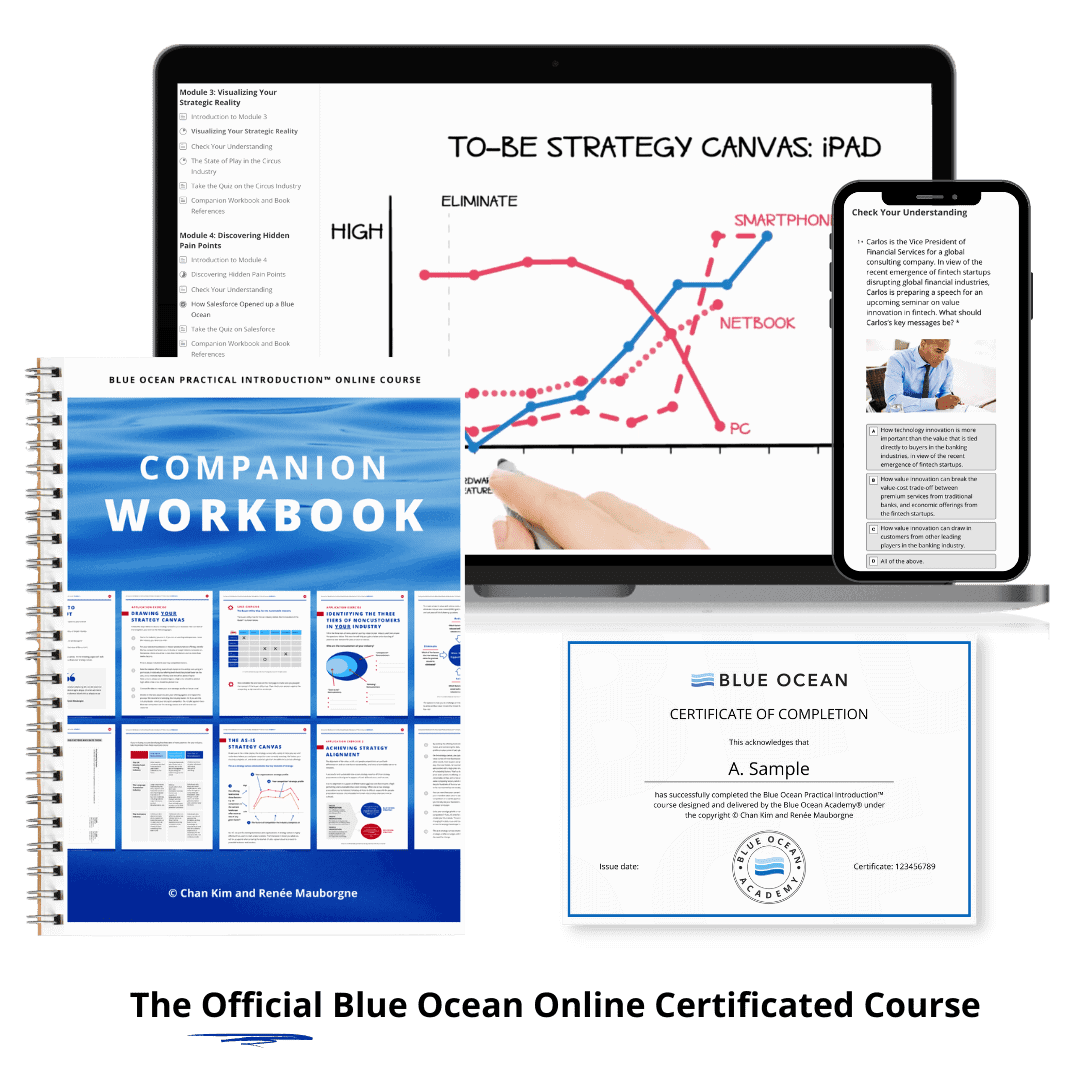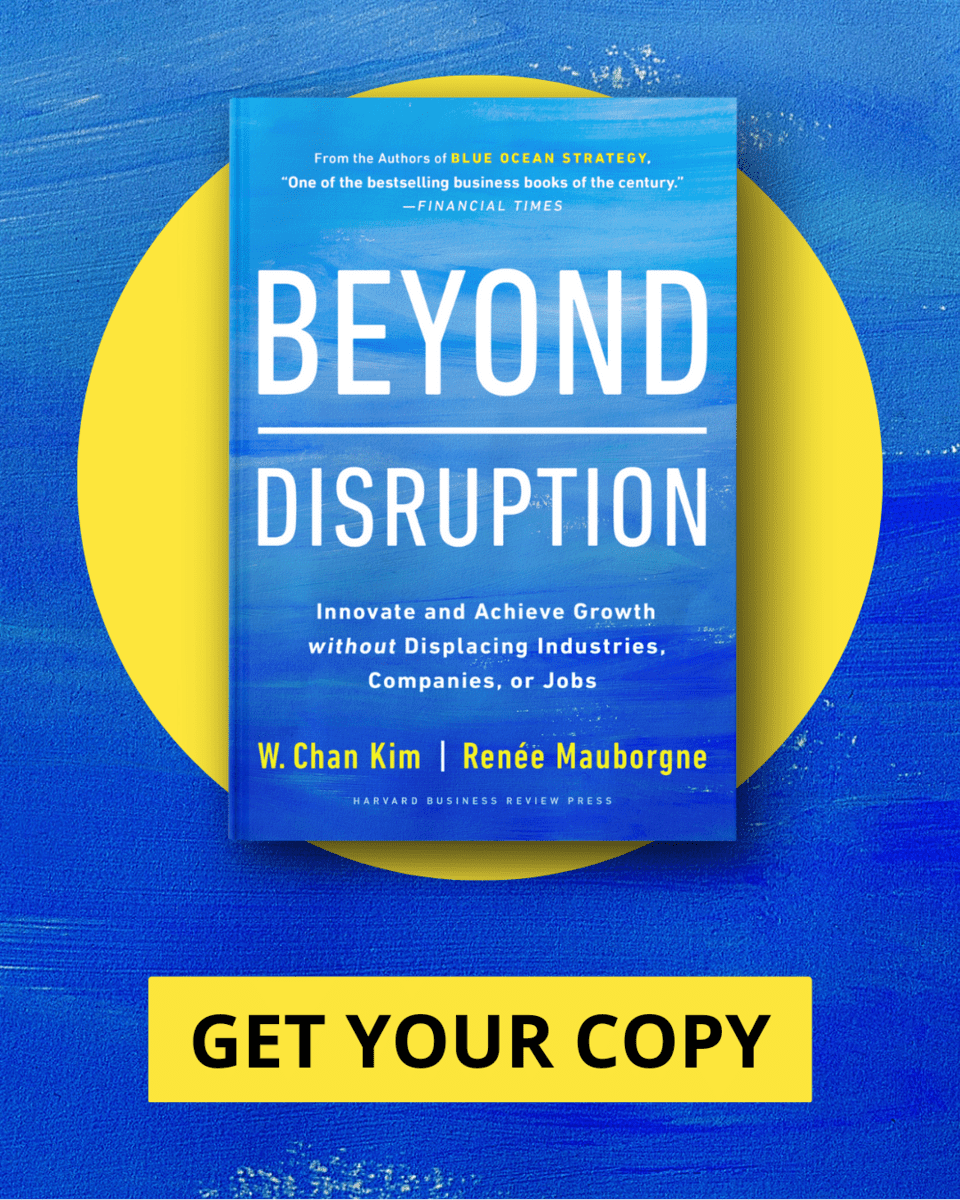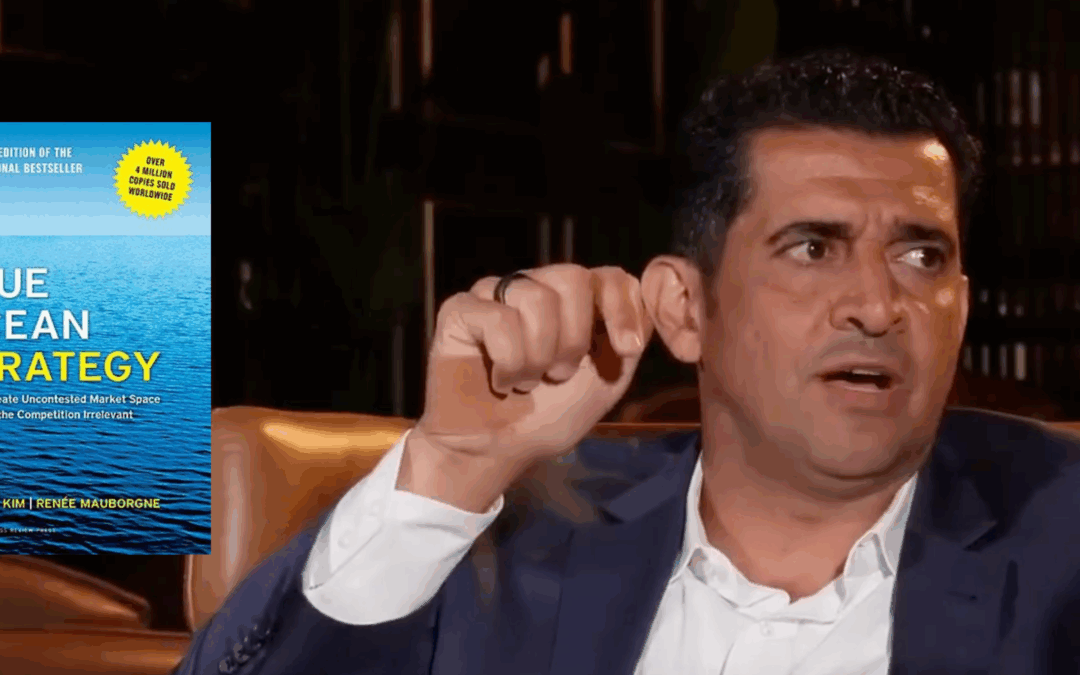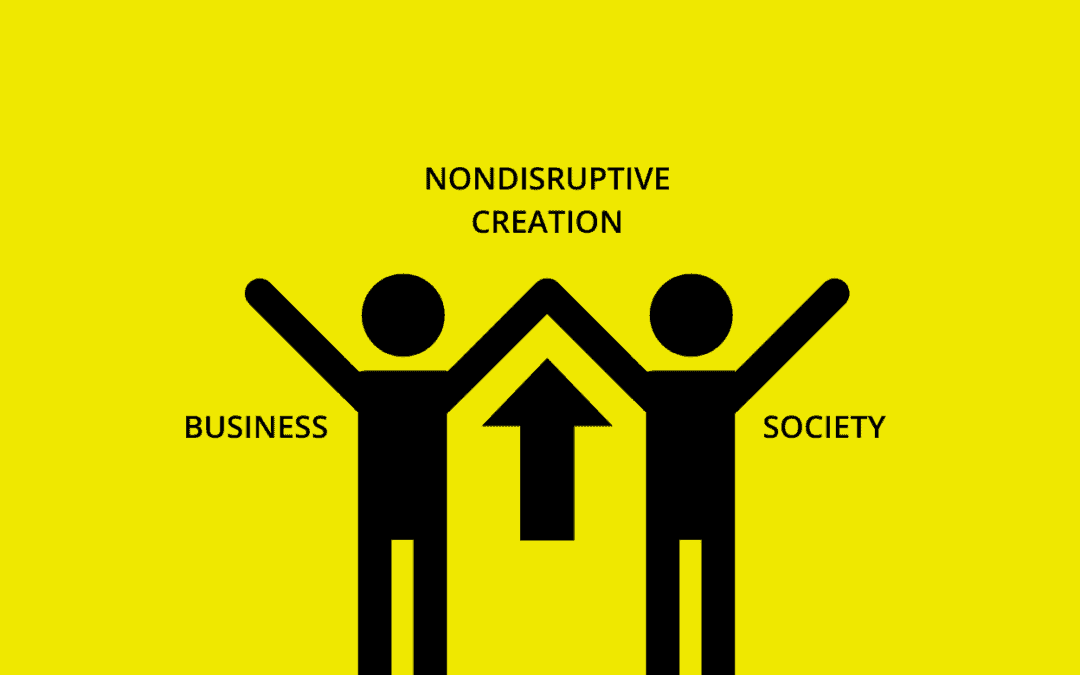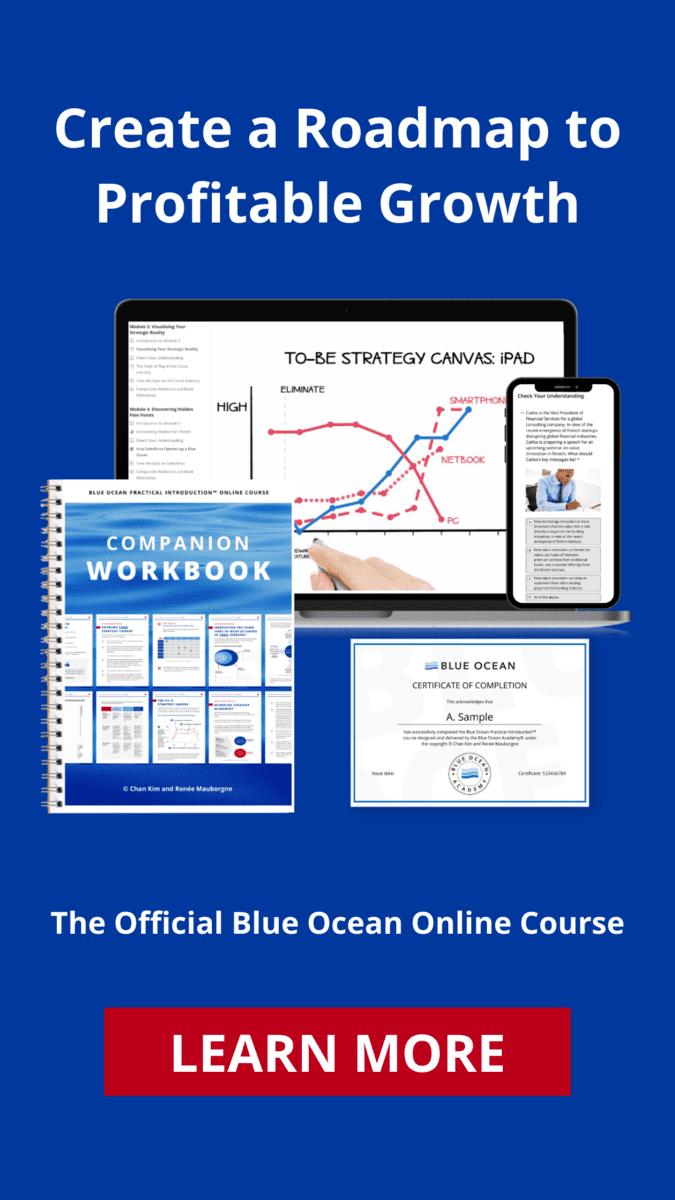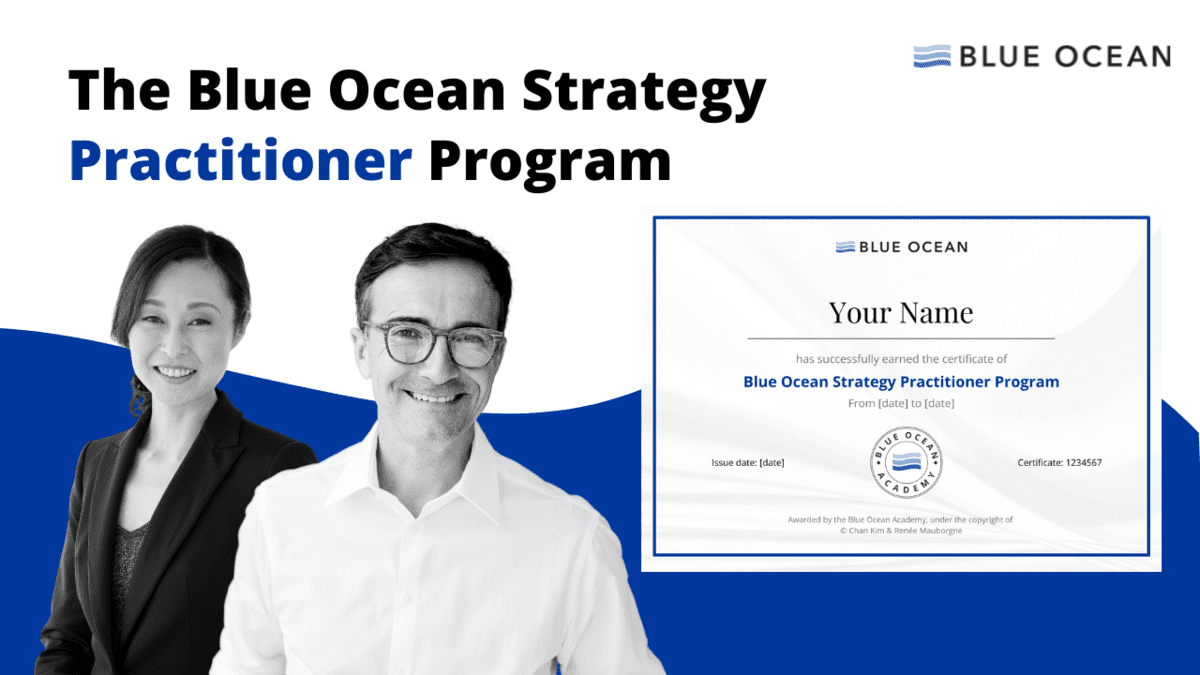Excerpts from Chan Kim & Renée Mauborgne’s Blue Ocean Strategy (2015) and their How Strategy Shapes Structure Harvard Business Review (September 2009) article.
Strategic alignment plays a critical role for the sustainability of a strategy. In this article, we will discuss a simple but comprehensive framework to fully develop and align an organization’s three strategy propositions from value to profit to people. We will explain the importance of strategic alignment for the sustainability of any strategy, whether blue or red, and compare successful and unsuccessful examples of strategic alignment.
For any business strategy to be successful and sustainable, the key divisions within an organization – those focused on value, profit, and people – must work together towards a strategic objective. In other words, they must be in alignment.
What is strategic alignment – definition
At the highest level, there are three propositions essential to the success of strategy: the value proposition, the profit proposition, and the people proposition.
For any strategy to be successful and sustainable, an organization must develop an offering that attracts buyers; it must create a business model that enables the company to make money out of its offering; and it must motivate the people working for or with the company to execute the strategy.
While good strategy content is based on a compelling value proposition for buyers with a robust profit proposition for the organization, sustainable strategy execution is based largely on a motivating people proposition. Motivating people requires more than overcoming organizational hurdles and winning people’s trust with fair process. It also rests on aligned and fair incentives.
In this sense, the three strategy propositions provide an organizing framework to ensure an organization is taking a holistic approach to the formulation and execution of strategy.
The strategic alignment framework
Blue Ocean Strategy aligns the following three propositions:
1. Value proposition: The utility buyers receive from the product or service minus the price they pay for it.
Is there a compelling reason for the mass of target buyers (customers and noncustomers) to purchase the new offering? Is the offering priced to attract the mass of target buyers so that they have a compelling ability to pay for it?
2. Profit proposition: The price of the offering minus the cost of producing and distributing it.
Achieving lower cost is achieved by eliminating and reducing factors that the industry has either taken for granted (e.g., legacy factors the industry still competes on but add little value); or over-delivered on.
3. People proposition: The readiness of employees to execute the new strategy with all of their energy, to the best of their abilities, and voluntarily.
The importance of strategic alignment
If a strategy does not fully develop and align the three strategy propositions, short-lived success or failure typically results. This is a trap many companies fall into. Lacking a holistic understanding of strategy, it is easy for an organization to focus overridingly on one or two strategy propositions to the exclusion of the other(s).
To make a successful blue ocean strategic move, an organization’s top executives must take responsibility for and ensure strategic alignment. Typically, executives with a strong functional bias cannot successfully fulfill this important role because they tend to focus on one rather than all of the three strategy propositions. A manufacturing department, for example, might neglect buyer needs, while a marketing department might focus only on the value proposition. This makes it imperative for top executives to develop fully aligned strategy propositions, effectively communicate them to managers in functional areas along with clear responsibilities and expectations. Effectively setting and achieving the strategic objectives in each functional area in line with the aligned strategy propositions will ensure an overall high-performing and sustainable strategy.
Creating a full set of consistent strategy propositions is essential whether a firm follows blue ocean or red ocean strategy. Where the two approaches diverge is in how organizations align their strategy propositions.
Under red ocean strategy, an organization’s three strategy propositions need to be aligned with the distinctive choice of pursuing either differentiation or low cost within given industry conditions.
Under blue ocean strategy, an organization succeeds when all three strategy propositions pursue both differentiation and low cost. It is this alignment in support of differentiation and low cost that ensures and sustains a successful blue ocean strategy.
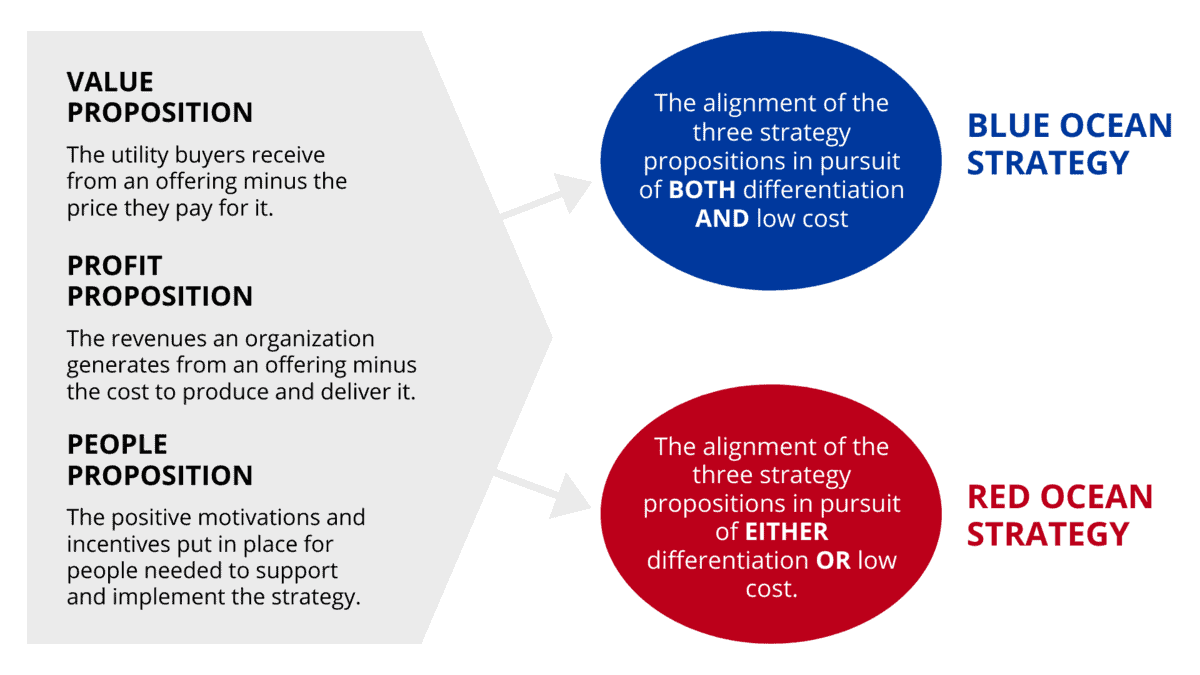
© Chan Kim & Renée Mauborgne. Blue Ocean Strategy. Blue Ocean Shift. All rights reserved.
Let’s look at two alignment examples. The first strategic alignment example will show how the city-state of Dubai achieved both differentiation and low cost to create a sustainable blue ocean. The second case study of Tata Nano will offer an example of strategic misalignment and its consequences.
Successful and unsuccessful examples of strategic alignment
How to achieve strategic alignment – case study of Dubai
In the midst of the Middle East, Dubai created a blue ocean in national progress and development which allowed it to rise from a small pearl-fishing and trading post to become a vibrant economy and ‘The City of Dreams’ – one of the top tourist destinations across the world. Unlike many of its regional peers which have developed unstable regimes and oil-dependent economies, Dubai has diversified its economy to become a politically stable economic powerhouse. Dubai thrives on trade, tourism, transportation, mass communications, construction, finance and a host of other growing sectors – with a business climate of optimism and expansion. Dubai has defied the expectations of conventional wisdom and has exhibited strong growth, sustained political stability and exceptional economic diversification.
The big question is what led to this transformative change in Dubai? Contrary to expectations based on local trends and regional development patterns, how has Dubai managed to achieve a diversified economy and a high degree of political stability, making it one of the most attractive destinations in the world not just for visitors but also for expatriate residents? How did it break out of the expected oil curse to create one of the fastest-growing economies in the world?
The underlying winning formula is the strategic alignment of its value, profit, and people propositions around differentiation and low cost.

Dubai aligned three strategic propositions.
Strategic alignment tools – the strategy canvas
Let’s briefly look at how Dubai aligned the three strategy propositions to reconstruct the environment and create a blue ocean using the strategy canvas.
The strategy canvas, an analytical framework of blue ocean strategy, allows us to express an organization’s three strategy propositions in simple, graphic form. The horizontal axis captures the range of factors organizations offer. The vertical axis depicts the offering level. The strategic profile is a graphic depiction of an organization’s relative performance across these key factors.
In this way, an organization can literally ‘see’ how compelling (or not) each of their propositions are and whether they are aligned. The strategy canvas is just one of the many blue ocean tools taught in the Blue Ocean Strategy online course. And check out other compelling examples of strategy canvases to learn how other organizations stood out from the crowd.
For an in-depth discussion on how Dubai achieved blue ocean strategy alignment, check out Chan Kim and Renée Mauborgne’s article, “How Strategy Shapes Structure” Harvard Business Review (September 2009).
1. Dubai’s Value Proposition
At the heart of Dubai’s success has been a value proposition to foreign investors that is unlike those of other emerging economies. The value proposition begins with a dozen world-class free trade zones with unbeatable incentives for investors. To stand out further and simultaneously lower investors’ costs, Dubai has also expedited its regulatory process in contrast to Shanghai which at the time imposed a complex and opaque legal system on foreign investors and required incoming companies to be familiar with China’s norms, customs, and politics.
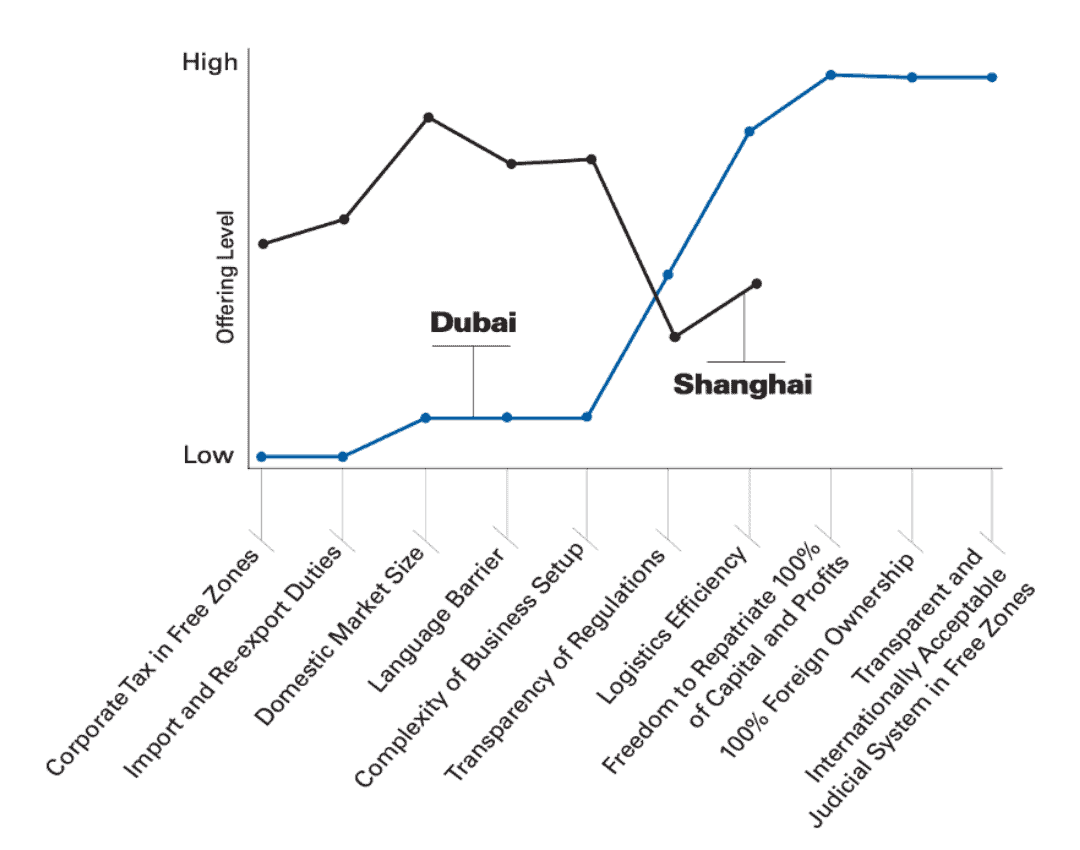
Shanghai was used as a strategic reference to show how Dubai’s value proposition has been compelling to foreign investors despite much smaller domestic market size.
2. Dubai’s Profit Proposition
How does Dubai generates revenue to support the state, given that corporate and personal taxes are negligible? It has done so by finding differentiated ways of generating revenues while also lowering its cost structure. Instead of exploiting conventional income channels such as corporate and personal taxes, which would discourage foreign investors, the government has invested in the infrastructure that supports the investors’ activities – shipping and port services, transport, tourism, etc. These investments have allowed the government to directly profit from its unique, low-cost value proposition.
Dubai’s profit proposition has been not just differentiated: economic development and government profitability are bolstered by the simultaneous pursuit of low costs. For example, in Dubai, expatriates always remain expatriates: some 80% of its growing population is now foreign. By restricting citizenship, the government has kept its social liabilities to a minimum.
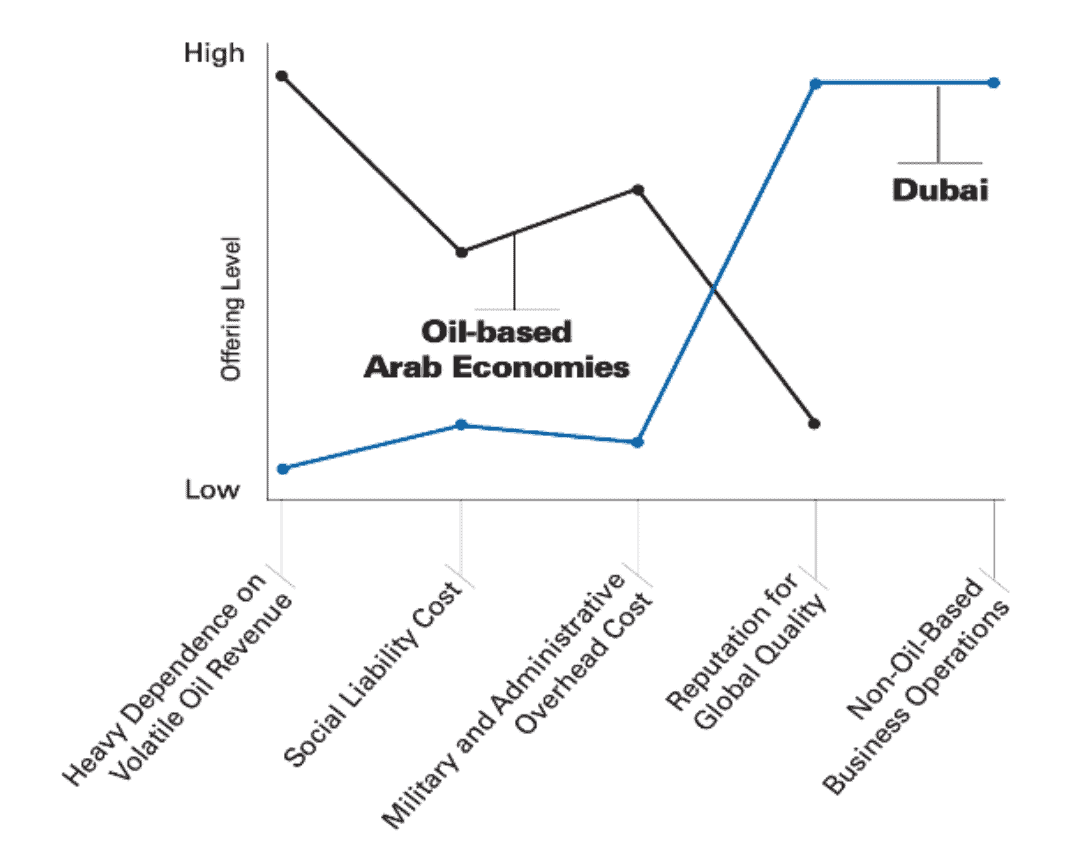
Oil-based Arab economies were used as a strategic reference, as these economies are most comparable in terms of their geopolitical, social, and government revenue-generating mechanisms.
3. Dubai’s People Proposition
Dubai has become a cosmopolitan state with more than 3 million people from over 100 countries around the globe.
1. How has Dubai preserved its Arab traditions and fostered social tolerance in its citizens while accommodating huge numbers of foreigners, many of them from the West and Asia?
2. With no social benefits or citizenship rights to offer, how did Dubai attract the foreign talent central to the government’s ability to execute its strategy?
The answer to both is that it created people propositions for both constituencies that have delivered differentiated value and lower costs. The people proposition embraces both economic and emotional factors, because these factors can either bring value to people or be a significant cost to their livelihoods.
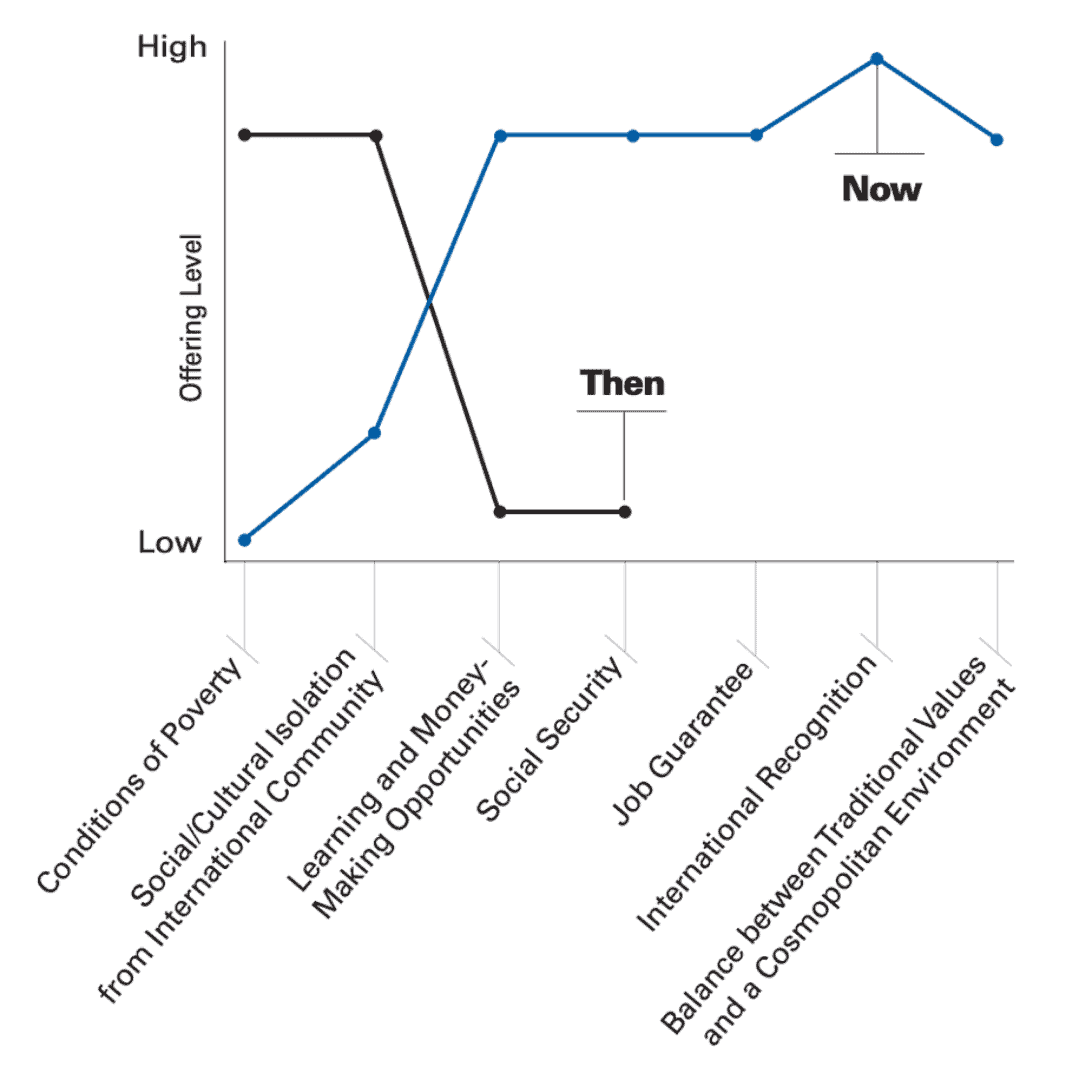
Dubai’s past was used as a strategic reference to depict how Dubai’s new strategy has made a difference to citizens.
Summary of Dubai’s strategic alignment
As Dubai’s case illustrates, aligning the three strategy propositions creates reinforcing synergies. With a compelling low-cost and differentiated value proposition, Dubai has attracted foreign businesses, and in serving them has found new and lucrative ways of making money. And because its value and people propositions have attracted foreigners in such numbers, Dubai has been able to create a cosmopolitan environment that is an appealing holiday destination and residence in its own right.
Finally, the profit proposition has allowed Dubai to reduce government overhead and use its business revenues to both reinvest in the businesses, thereby giving foreign investors more reason to go there, and providing its own citizens a quality of life their ancestors could not have imagined.
The benefits of strategic alignment
Blue ocean strategy requires the alignment of the three strategy propositions—value, profit, and people. Once it is successfully implemented, it is hard to copy because, while imitators could get one or two propositions right, they are unlikely to align all three of them.
However, eventually, any strategy is imitable and a blue ocean may also turn red. This is exactly why blue ocean strategy never intends to offer a one-time solution to companies. Rather, it calls for companies to monitor their value curves conscientiously and renew their blue ocean offerings by taking new blue ocean strategic moves at the proper time. Thus, blue ocean strategy is not a one-time shot but requires a series of strategic moves to complete its strategic renewal.
Strategic misalignment and its consequences
When the three strategy propositions are not properly aligned, even a compelling blue ocean idea with an impressive market entry may not sustain its appeal. A telling example here is Tata Nano, which was hailed at its launch as ‘The People’s Car’.
Tata Nano – example of strategic misalignment
At its launch, the Tata Nano was hailed as the people’s car. Produced by Indian automaker, Tata Auto, the Nano garnered more media attention than any other car launch in the world at the time, achieving the biggest sales uptake in the history of the global automobile industry. More than two hundred thousand orders poured in within two weeks of its launch in March 2009.
There was good reason for the Nano’s initial success. Tata Motors had thought hard about what Indian buyers wanted, valued, and lacked in India’s existing transportation options. The Tata Nano offered a safe, comfortable, reliable, and respectable all-weather means of transportation for Indian families.
At the same price as a two-wheeler, it put an automobile within the reach of most Indians for the first time. Tata Motors matched this compelling value proposition with a compelling profit proposition. A series of cost innovations in design, manufacturing, marketing, and maintenance resulted in a profit proposition that was both differentiated and low cost.
Yet the Tata Nano, an initial success, failed to meet sales targets and public expectations.
What went wrong?
It had a brilliant value proposition. A viable profit proposition. And a strong people proposition for employees and suppliers. This setback arose largely from a major weakness in the people proposition for the external stakeholders whose cooperation Tata depended on.
Resistance from the local community eventually forced the manufacturing plant to relocate across the country, incurred huge costs for the company, and disrupted its original distribution plan, leading to less-than-satisfactory sales results.
Instead of using non-traditional channels to make the Tata Nano reach Indian families throughout the country as had been planned, Tata Motors resorted to traditional dealerships for the display and sale of the Nano as they were distracted by the plant relocation. As a result, the car was displayed only in large showrooms in big cities.
As typical two-wheeler buyers were reluctant to walk into a large car showroom, the “people’s car” reached existing car owners who were looking to buy a cheap second car.
As the reputation of Tata Nano shifted from being the “people’s car” to the “cheapest car” as perceived by existing car owners, two-wheeler owners were further turned off as what they wanted was not only better mobility but also an upgrade in their socioeconomic status.
It was the mistakes made in the people proposition that eventually backfired on the Tata Nano’s value proposition.
Achieving strategic alignment
Do you have a holistic understanding of strategy? What are you doing today to ensure strategic alignment in your organization? Is your team aligned around your strategy? Are you able to clearly communicate what your strategic objectives are and have your team’s buy-in?
World-Class Learning for Your Team
Strengthen the strategic thinking, innovation, and creativity of your employees and business leaders through online learning.
The Blue Ocean Sprint is a self-access online course and workbook that will help you learn and apply the tools, frameworks and processes to unlock a blue ocean.
The course will create a shared understanding among the team about the current situation your organization is in and the need to change the status quo.
Designed for busy executives in mind, this course is an efficient and effective way of developing a common-language system to achieve strategic alignment in your organization.
Find out more about the Blue Ocean Online Course.


